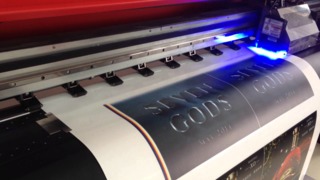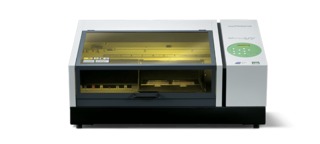What's New in UV-Curable Wide-Format Printing?
Technological advances and application-driven requirements drive developments in the wide-format digital printing market.

Technological advances and application-driven requirements drive developments in the wide-format digital printing market. The printer-ink combination is typically limited to a specific set of applications—aqueous-based inks for indoor applications, dye sub for the textile market, latex for indoor signage, vinyl, textile and short-term exterior graphics, solvent for long-term exterior graphics and interior graphics, and UV for exterior applications.
“Long-term water-based ink offers a better ink set, in terms of environmental and gamut, but given UV’s resistance to weather conditions, it is a better fit for outdoor applications,” acknowledged Mike Pruitt, Senior Product Manager, Industrial Markets, Epson. “UV is a better solution than solvent, as it offers lower toxicity. “
While Epson offers a line of UV wide format printers—including the SinoColor UV-740 Series with the water cooling UV-LED lamp—Pruitt sees UV as having limited play in the wide format market, citing aqueous as a better overall choice and pointing out that when laminated, water-based is as tough as UV.
However, advances in UV-LED based cooler curing have broadened the substrates available to wide-format customers. With LED curing, wide-format customers can print on thin or plastic substrates, which would melt using a hotter cure.
Bridging the Gap
UV-LED cure technology (which uses lamps with light-emitting diodes as opposed to mercury lamps) bridges the gap between the technologies, offering more versatility in the process, said Michael Maxell, Senior Manager, Mimaki USA.
“Solvent and latex technologies often fall short on more involved applications that require white or light sources, such as back lit and static clings,” he said.
Mimaki’s current products are based on a next generation UV-LED curable platform designed to broaden the range of potential applications, said Maxell.
As LED and ink technology have advanced, Sun Chemical responded with a series of graphic inks under the Crystal product range, which fully cure with LED-UV exposure.
“Most of the inkjet inks we sell today for signage applications cover a wide spectrum of conventional UV curing technology,” said Peter Saunders, Business Director of Digital at Sun Chemical. “However, we are seeing significant growth in UV LED with many bigger players in the market looking at UV LED because of its environmental and application benefits.
Printers using UV-LED curable leverage the technology to create products that traditionally would require two or more other inks to achieve. “We believe this will usher in a new era of wide-format printing with UV-LED curable taking the lead position in the market, surpassing even solvent,” sad Maxwell.
“Mimaki’s curable technologies open up the possibility of printing on clear and colored media with more control,” said Maxwell. Its newly introduced four-layer print technology lets Mimaki customers produce images that are altered when the light source is changed, creating a new space for target advertisements and retail applications. For example, a 3 layer print gives balanced control over an image that is intended to be front and back lit, where a 5 layer print give control of prints that require a different image on each side of the media. UCJV Series operators can create general signage, decals, and vehicle wraps with industry defining warranties, to more expansive products such as canvas prints, flag & banner, back-lit & static clings utilizing layered print technology with white ink.
Along with its printers, Mimaki has also developed Mimaki Original Inks for the UV-LED space. “Each ink has a unique set of characteristics and potential,”said Maxwell.
Looking to the Future
For Sun Chemical, UV LED, and UV inks are central to its research and development focus. “Performance is the key attribute our customers are looking for and it is at the forefront of what we offer,” noted Saunders. Our customers associate our specially formulated inks with a high degree of enduring flexibility. Their equipment is running faster, and the inks need to cure on a wide range of substrates. Price is often a factor for our customers, but it is balanced off by their application needs and the versatility of the ink’s performance on many substrates. Ink performance is always the key.
At FESPA 2018, Ricoh demonstrated the ability of its Ricoh Pro T7210 UV flatbed printer– as well as its full line of wide-format machines – with its Bianchi Corner, a simulation of a typical Bianchi shop, the high-end Italian bicycle retailer. Along with rigid display panels created by the T7210 UV flatbed, were rigid totems, cut out bike shapes and 2m x 1m and 3m x 2m wall boards, all on 5mm Forex, and bike details on 500mm x 350mm 4mm thick clear Plexiglass.
Introduced in spring 2017, the T7210 UV flatbed printer is designed to meet the graphic needs of the industrial décor market.
In touting its UV curable product offerings, Roland DGA has shifted the conversation from technology to marketing. “Our mantra right now is to offer a strong approach to customization and personalization,” said Jay Roberts, Roland DGA’s Product Manager, UV Printers.
Shifting its paradigm shift around 18 months ago. Roland’s approach to the UV wide format market is to delineate different scenarios for approaching different markets.
“We are changing the philosophy of product; moving from overseas manufacturing of mass marketed products to personalized or customized products with the company’s or person’s info,” explained Roberts.
“Our RIP has variable-data capabilities that enhance the customization process,” he continued. “Customization adds value to the product. A regular lunchbox sells for $5; a customized lunchbox, personalized for the customer, is a $25 product.”
Roland offers an array of UV printers, from smaller series desktops to larger 64-inch flatbed for industrial printers. Its customers also span a wide range, from corporations who use its UV tabletop printers for internal use, to graphic arts shops that are printing 500 custom coasters on a flatbed.
In house at a corporation, for example, the human resources department might use the desktop model when onboarding a new employee, with personalized mugs, pens, hats, etc., with the new employee’s name, as part of a welcome package.
Large productions shops are using the RIPs variable data capability to print customized products for companies, let’s say an 100,000 gifts for customers customized with the company’s name.
One Roland customer, PhoneGadget, based in Ringstadt, invested in a VersaUV LEF-12 – Roland’s benchtop UV flatbed – to produce printed covers with personalized photos and graphics. PhoneGadget customers upload their favorite picture or graphics online, which are printed directly onto a smartphone or tablet cover.
California-based ARB Digital uses Roland’s VersaUV LEF-12 desktop flatbed printer to print on substrates like aluminum, steel, wood, tile and various papers. Clients such as restaurants and artists are excited about the ability to print on unique subtrates.
UV and LED inks will remain the chemistry of choice for the foreseeable future, said Saunders. “We see water-based ink technology as a great opportunity for the future perhaps but, for now, high performance UV will remain the mainstream, with a clear trend to LED cure."


